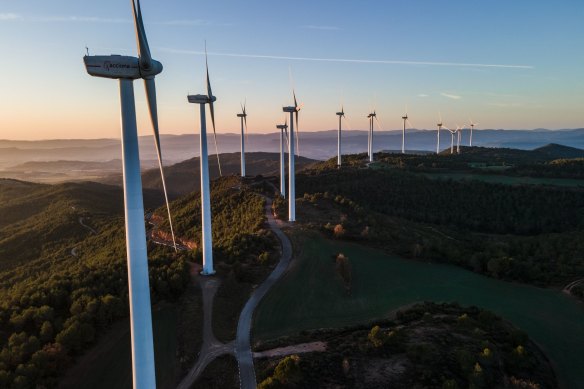Record growth in solar, EVs leaves open ‘narrow path’ to net zero
Save articles for later
Add articles to your saved list and come back to them any time.
Record growth in solar energy and electric car sales since 2021 has left open a narrow path in the energy sector to net zero emissions, the International Energy Agency has found, but a tripling of renewable capacity is needed in the coming decade to remain on track.
Should the world achieve the goal, fossil fuel demand would be driven down by 25 per cent by 2030, lowering emissions by 35 per cent, compared with the all-time high recorded in 2022. By 2050, fossil fuel demand would fall by 80 per cent.
The global surge in renewables will need to increase to keep the path to net-zero open.Credit: Bloomberg
“Keeping alive the goal of limiting global warming to 1.5 degrees requires the world to come together quickly,” said IEA executive director Fatih Birol on Tuesday, launching an update to the organisation’s landmark 2023 net zero road map.
“But we also have a very clear message: strong international co-operation is crucial to
success. Governments need to separate climate from geopolitics, given the scale of the challenge at
hand.”
This month, Birol wrote in an opinion piece for the Financial Times that the world was now at “the beginning of the end” of the fossil era.
“There’s a taboo in the traditional energy sector against suggesting that demand for the three fossil fuels – oil, gas, and coal – could go into permanent decline,” he wrote.
But “this age of seemingly relentless growth is set to come to an end this decade, bringing with it significant implications for the global energy sector and the fight against climate change”, Birol argued.
The International Energy Agency’s new net zero scenario demands that the annual rate of energy efficiency improvements doubles, that sales of electric vehicles and heat pumps rise sharply, and that energy sector methane emissions fall by 75 per cent. It finds that these strategies, which rely on proven and “often cost-effective” technologies, together deliver 80 per cent of the reductions needed by the end of the decade.
It also finds significant improvements since its original 2021 report. That year it found that technologies not yet available on the market delivered nearly half of the emissions reductions needed for net zero in 2050. That number has fallen to about 35 per cent in this year’s update.
The report stressed the importance of meeting early emissions reductions targets to avoid the necessity of developing and deploying technology to remove carbon from the atmosphere later to keep warming under 1.5 degrees.
A failure to expand clean energy quickly enough by 2030 means that nearly 5 billion tonnes of carbon dioxide would have to be removed from the atmosphere every year during the second half of this century, the report found.
In a speech in Queensland to the national drought forum, Treasurer Jim Chalmers warned that Queensland faces warming of up to 1.9 degrees over the coming three decades, with potentially huge economic impacts.
“The latest analysis out of Treasury tells us that disasters and a warming climate have big, economy-wide effects,” Chalmers told the forum.
“The Black Summer bushfires and October 2022 floods cost the Australian economy around $1.5 billion each, and the latest projections also show the significant impact that climate change could have on our regions,” he said.
“If further action isn’t taken, Australian crop yields could be 4 per cent lower by 2063, costing us about $1.8 billion in GDP in today’s dollars.
“Commonwealth funding under the DRFA [disaster recovery funding arrangements] for severe events has increased by 433 per cent over just three years, and what was $335 million in Commonwealth spending on disaster recovery in 2017-18, has become around $2.5 billion in 2022-23.
“So, the pressure of a changing climate and more frequent natural disasters is constant, cascading, and cumulative.”
The Business Briefing newsletter delivers major stories, exclusive coverage and expert opinion. Sign up to get it every weekday morning.
Most Viewed in Environment
From our partners
Source: Read Full Article
